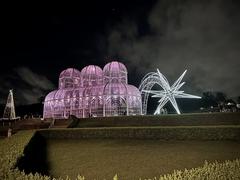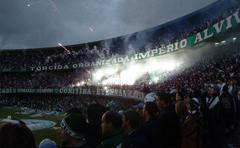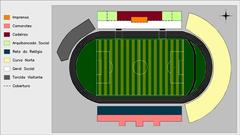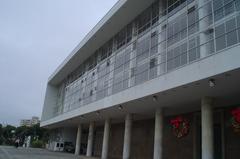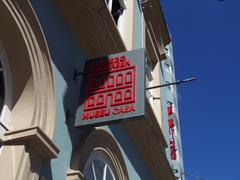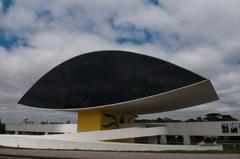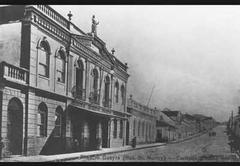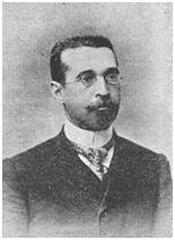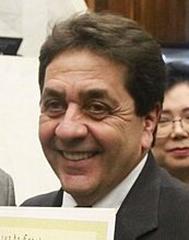Estádio Janguito Malucelli: Visiting Hours, Tickets, and Guide to Curitiba Historical Sites
Date: 04/07/2025
Introduction
Estádio Janguito Malucelli, affectionately known as the “Ecoestádio,” was a pioneering football stadium in Curitiba, Brazil. Recognized as the country’s first ecological stadium, it became an emblem of sustainable architecture, blending seamlessly into the natural landscape adjacent to Parque Barigui. Though demolished beginning in 2019, its innovative design and cultural legacy continue to inspire conversations around urban planning, environmental stewardship, and football heritage in Curitiba. This guide provides a detailed overview of the stadium’s history, unique features, practical information for visitors, and suggestions for exploring related attractions in the area.
For further background, see Curitiba Histórica, Globo Esporte, and Virgula.
Table of Contents
- Introduction
- Origins and Construction
- Architectural and Environmental Features
- Role in Local Sports Culture
- Notable Events and Milestones
- Decline and Current Status
- Visitor Information: Hours, Tickets, and Accessibility
- Nearby Attractions
- Frequently Asked Questions (FAQ)
- Conclusion and Call to Action
- References
Origins and Construction
Estádio Janguito Malucelli was inaugurated in 2007 by the Malucelli and Trombini families, initially serving as the home of Malutrom (later J. Malucelli Futebol S/A)—Brazil’s first club-empresa, a professional football club structured under corporate principles as permitted by the Lei Pelé (Globo Esporte). Strategically located near Parque Barigui, the stadium was integrated into a neighborhood known for its recreational spaces and proximity to other landmarks, such as the Museu do Automóvel and the Suíte Vollard building.
Architectural and Environmental Features
Estádio Janguito Malucelli stood out for its ecological design. The main grandstand was built directly into a grassy hillside, eliminating the need for concrete, and featured seating on wooden terraces made from reforested wood (Virgula). Other facilities, including press boxes and locker rooms, relied on sustainable materials. The stadium’s capacity was modest—just over 4,000 spectators—but its atmosphere was unique, with local wildlife often seen during matches (Última Divisão), and a sense of harmony between built and natural environments.
Role in Local Sports Culture
J. Malucelli Futebol S/A, also known as “Jotinha,” was the stadium’s primary tenant, marking a transformative period in Brazilian football as the first club-empresa. The team won several regional titles, including the Campeonato Paranaense Second Division (1998), Módulo Branco of the Copa João Havelange (2000), and Copa Paraná (2007), and finished as runner-up in the 2009 Campeonato Paranaense (Globo Esporte). The stadium also served as a temporary home for Athletico Paranaense during renovations for the 2014 FIFA World Cup, with temporary stands expanding capacity to over 6,000 (Curitiba Histórica).
Notable Events and Milestones
Although never a FIFA World Cup match venue, the stadium was used as a training ground for international teams in 2014. It also hosted matches for clubs in Campeonato Paranaense and Copa Paraná. In its final years, the stadium’s reputation was marred by administrative disputes, including the “Caso Getterson,” which led to the club’s suspension from professional football in 2017 (Globo Esporte).
Decline and Current Status
After 2017, the stadium fell into disuse, with the grounds becoming overgrown and structures deteriorating (Última Divisão). In 2019, the land was sold for redevelopment, and by 2021, the stadium had been demolished to make way for a residential and commercial complex (Curitiba Histórica). The site is now under construction and closed to the public.
Visitor Information: Hours, Tickets, and Accessibility
Visiting Hours and Tickets
- Current Status: The stadium is demolished and not open to visitors. There are no visiting hours or ticket sales.
- Historic Access: When operational, the stadium was typically open for events and matches, sometimes with free or low-cost admission (Guia da Semana).
- Present-Day Recommendation: Visitors interested in the stadium’s legacy should focus on exploring Parque Barigui and nearby cultural attractions, as the stadium site is now private property under development.
Accessibility
The stadium’s previous eco-friendly design used grass terraces and wooden benches, which may have posed challenges for visitors with reduced mobility. Current site access is restricted due to construction; always respect posted signs.
Nearby Attractions
- Parque Barigui: A popular urban park offering trails, picnic areas, lakes, and abundant wildlife. Open daily, with amenities such as restrooms and food kiosks.
- Museu do Automóvel: Features vintage cars and is located within Barigui Park.
- Downtown Curitiba: Offers a wealth of historical sites, architecture, shops, and restaurants.
- Suíte Vollard: An architectural landmark known for its rotating apartments.
Travelers are encouraged to combine a visit to Barigui Park with exploration of other sustainably minded sites in Curitiba.
Frequently Asked Questions (FAQ)
Q: Can I visit Estádio Janguito Malucelli today?
A: No, the stadium has been demolished, and the site is currently closed to the public due to construction.
Q: What are the visiting hours?
A: There are no official visiting hours for the stadium site. Barigui Park, however, is open daily from morning to evening.
Q: Are there tickets or guided tours available?
A: There are no tickets or tours for the former stadium. Local museums may offer exhibits related to its history.
Q: How do I get to the area?
A: Barigui Park is accessible by public transportation, taxis, and ride-sharing services from central Curitiba.
Conclusion and Call to Action
Estádio Janguito Malucelli’s story is a compelling chapter in Curitiba’s legacy of innovation, environmental consciousness, and sports culture. Though the Ecoestádio no longer stands, its influence persists in the city’s urban identity and serves as a benchmark for sustainable stadium design. Visitors to Curitiba are encouraged to explore Parque Barigui and other historical sites, reflect on the city’s commitment to sustainability, and continue learning about Brazil’s pioneering approaches to architecture and football.
For more information on Curitiba’s historical and ecological attractions, download the Audiala app, explore our related articles, and follow our social media channels for the latest updates and travel tips.
For images and virtual tours of the former stadium and Parque Barigui, see official tourism sites and local archives. Use descriptive alt tags like “Ecoestádio grass terraces” and “Sustainable football stadium Curitiba” for best SEO results.

